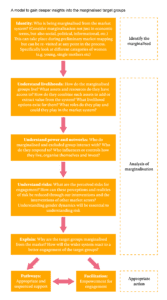PDF Download: Marginalisation Analysis
In a nutshell: Marginalisation analysis involves understanding who marginalised actors are, and the forces and structures that impact their choices and lives. It enables projects to be designed so that they maximise the involvement and empowerment of marginalised groups in market development.
Status: Core Tool
Key principles: By better understanding power structures and networks that reinforce, and benefit from, marginalisation (Systems Thinking), action can be taken to ensure participation. Inevitably this will involve looking at the forces that drive marginalisation according to gender.
Preconditions and preparation: This analysis can be undertaken at any time. It requires critical thinking from staff, and sufficient access to communities to engage in conversations.
Outputs
Information on the characteristics of different marginalised groups, that can be used to update the market map if necessary. The insights from Marginalisation Analysis should inform Root Cause Analyses of the market system.
Marginalisation analysis is an iterative process of posing questions, engaging with communities, and interpreting the responses. The model below lays out the sequence of questions to be asked:

Outcomes/behaviour changes
This analysis may lead to greater self-awareness from marginalised groups, or from more powerful actors who start to reflect on their own role in perpetuating poverty. The challenge is to link these insights with market actors’ self-interest, in order to motivate changes in behaviour.
Resources and templates:
Empowering Marginalised Actors Guidelines